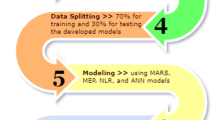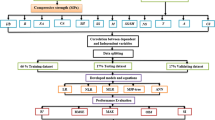Abstract
In practice, it is very common to estimate the strength of concrete by destructive or by partial non-destructive testing on concrete. However, it is a very challenging task to estimate the correct value of the strength of concrete or cement as it is depending on various factors. The present research work is focussed on the impact of zinc oxide (ZnO) nano-particles on the compressive strength of the cement mortar. To investigate the modified compressive strength of the mortar incorporated with ZnO nano-particles, four different types of mixes were prepared with 0%, 0.25%, 0.5%, and 0.75% of the ZnO nanoparticle by the weight cement, respectively. Experimental results show the enhancement in compressive strength up to 0.5%, later on, strength is slightly decreased. By considering the experimental results of cement strength, three different models are proposed to predict the strength of cement mortar as analysis of covariance (ANCOVA), neural network (NN), and principal component regression (PCR). These models also validate the results of experimentation by showing the optimum results at 0.5% of the addition of ZnO nano-particles. These models are trained and tested in excel programming for thirty-six standard cement specimens. At the end of the work, each model is compared with others. Out of three models, the NN model can predict the reliable results for the compressive strength. However, the PCR model is in second place after the NN model though its value of R2 is lesser than the ANCOVA model. PCR gives less residue as compared to ANCOVA. For the prediction of the strength of mortar, ANCOVA is not so significant as compared to the other two models due to the residuals of ANCOVA models are the largest value, though its R2 value is more than the PCR model.






Similar content being viewed by others
References
Abdi H, Chin WW, Vinzi VE et al (2013) New perspectives in partial least squares and related methods. Springer Proc Math Stat 56:65–78. https://doi.org/10.1007/978-1-4614-8283-3
Borucka-Lipska J (2016) Acid resistance, water permeability and chloride penetrability of concrete containing crushed basalt as aggregates. Neural Comput Appl 31:137–150. https://doi.org/10.1007/s00521-017-3007-7
Asteris PG, Ashrafian A, Rezaie-Balf M (2019) Prediction of the compressive strength of self-compacting concrete using surrogate models. Comput Concrete 24:137–150. https://doi.org/10.12989/cac.2019.24.2.137
Raman SN, Salam A, Jumaat MZ (2016) Modeling of compressive strength for self-consolidating high-strength concrete incorporating palm oil fuel ash. Materials 9:1–13. https://doi.org/10.3390/ma9050396
Al-Khatib MI, Al-Martini S (2019) Predicting the rheology of self-consolidating concrete under hot weather. Proc Inst Civil Eng Constr Mater 172:235–245. https://doi.org/10.1680/jcoma.16.00055
Islam MS, Alam S (2013) Principal Component and Multiple Regression Analysis for Steel Fiber Reinforced Concrete ( SFRC ) Beams. 7:303–317. https://doi.org/10.1007/s40069-013-0059-7
Manoj A, Babu Narayan KS (2019) Proper orthogonal decomposition for generation of organized data in concrete technology. Ukieri concrete Congress, concrete. The Global Builder
Naizot T, Auda Y, Dervieux A et al (2004) A new multi-temporal analysis of satellite images using principal componenet analysis: a case studt using landsat TM images of the Camargue, France. Int J Remote Sens. https://doi.org/10.1080/01431160310001642313
Khademi F, Akbari M, Mohammadmehdi S, Nikoo M (2017) Multiple linear regression, artificial neural network, and fuzzy logic prediction of 28 days compressive strength of concrete. Front Struct Civ Eng 11:90–99. https://doi.org/10.1007/s11709-016-0363-9
Douma OB, Boukhatem B, Ghrici M (2014) Prediction compressive strength of self-compacting concrete containing fly ash using fuzzy logic inference system. Int J Civil Environ Struct Constr Arch Eng 8:1285–1289
Cook R, Lapeyre J, Ma H, Kumar A (2019) Prediction of compressive strength of concrete: critical comparison of performance of a hybrid machine learning model with standalone models. J Mater Civ Eng 31:1–15. https://doi.org/10.1061/(ASCE)MT.1943-5533.0002902
Alsanusi S, Bentaher L, Salem A, Loubna B (2015) Prediction of compressive strength of concrete from early age test result using design of experiments (RSM). Int J Civil Environ Struct Constr Arch Eng 9:1559–1563. https://doi.org/10.13140/RG.2.1.3270.7684
Moutassem F, Chidiac SE (2015) Assessment of concrete compressive strength prediction models. KSCE J Civ Eng 00:1–16. https://doi.org/10.1007/s12205-015-0722-4
Sadowski Ł, Nikoo M, Nikoo M (2015) Principal component analysis combined with a self organization feature map to determine the pull-off adhesion between concrete layers. Constr Build Mater J 78:386–396. https://doi.org/10.1016/j.conbuildmat.2015.01.034
Marangu JM (2020) Prediction of compressive strength of calcined clay based cement mortars using support vector machine and artificial neural network techniques. J Sustain Constr Mater Technol 5:392–398. https://doi.org/10.29187/jscmt.2019.43
Eskandari-Naddaf H, Kazemi R (2017) ANN prediction of cement mortar compressive strength, influence of cement strength class. Constr Build Mater 138:1–11. https://doi.org/10.1016/j.conbuildmat.2017.01.132
Haecker CJ, Garboczi EJ, Bullard JW et al (2005) Modeling the linear elastic properties of Portland cement paste. Cem Concr Res. https://doi.org/10.1016/j.cemconres.2005.05.001
Verma K, Ram S, Verma A (2019) Prediction of compressive strength of cement mortar in normal and aggressive environment using artificial neural network. Int J Appl Eng Res 14:3435–3441
Eskandari H, Gharouni M, Mahdi M (2016) Prediction of mortar compressive strengths for different cement grades in the vicinity of sodium chloride using ANN. Proc Eng 150:2185–2192. https://doi.org/10.1016/j.proeng.2016.07.262
Shaqadan AA, AL-Rawashdeh, (2018) Prediction of concrete mix compressive strength using statisticallearning models. J Eng Sci Technol 13:1916–1925
Bidkar KL, Jadhao PD (2019) Prediction of strength of remixed concrete by application of orthogonal decomposition, neural analysis and regression analysis. Open Eng 9:434–443. https://doi.org/10.1515/eng-2019-0053
Ghanbari A, Karihaloo BL (2009) Prediction of the plastic viscosity of self-compacting steel fibre reinforced concrete. Cem Concr Res 39:1209–1216. https://doi.org/10.1016/j.cemconres.2009.08.018
Nagwani NK, Deo SV (2014) Estimating the concrete compressive strength using hard clustering and fuzzy clustering based regression techniques. Sci World J. https://doi.org/10.1155/2014/381549
Chen H, Qian C, Liang C, Kang W (2018) An approach for predicting the compressive strength of cement-based materials exposed to sulfate attack. PLoS ONE. https://doi.org/10.1371/journal.pone.0191370
Belalia Douma O, Boukhatem B, Ghrici M, Tagnit-Hamou A (2017) Prediction of properties of self-compacting concrete containing fly ash using artificial neural network. Neural Comput Appl 28:707–718. https://doi.org/10.1007/s00521-016-2368-7
Indian Standard (1991) IS:1489 (Part 1):1991 Portland Pozzolona Cement Specification. In: Bureau of Indian Standards, New Delhi, THIRD. Bureau of Indian Standards, INDIA, p 57
Indian Standard (2016) IS:383 (2016) Coarse and fine aggregate for concrete-specification. In: Bureau of Indian Standards, New Delhi
Cullity BD (1967) Elements of X-ray diffraction, 3 rd. Addison-Wesley, New York
Khoshhesab ZM, Sarfaraz M, Asadabad MA (2011) Preparation of ZnO nanostructures by chemical precipitation method. Synth React Inorg Met-Org Nano-Met Chem 41:814–819. https://doi.org/10.1080/15533174.2011.591308
Zhou J, Zhao F, Wang Y et al (2007) Size-controlled synthesis of ZnO nanoparticles and their photoluminescence properties. J Lumin 122–123:195–197. https://doi.org/10.1016/j.jlumin.2006.01.089
Indian Standard (2005) IS: 4031 (Part 6)-1988 Determination of compressive strength of hydraulic cement other than masonry cement. In: Bureau of Indian Standards, New Delhi. pp 1–3
Chatterjee A, Das D (2013) Assessing flow response of self-compacting mortar by Taguchi method and ANOVA interaction. Mater Res 16:1084–1091. https://doi.org/10.1590/S1516-14392013005000083
Lin CJ, Wu NJ (2021) An ann model for predicting the compressive strength of concrete. Appl Sci (Switzerland). https://doi.org/10.3390/app11093798
Tang CW (2006) Using radial basis function neural networks to model torsional strength of reinforced concrete beams. Comput Concrete 3:335–355. https://doi.org/10.12989/cac.2006.3.5.335
Mazloom M (2013) Application of neural networks for predicting the workability of self-compacting concrete. J Sci Res Rep 2:429–442
Charhate S, Subhedar M, Adsul N (2018) Prediction of concrete properties using multiple linear regression and artificial neural network. J Soft Comput Civil Eng 2:27–38
Hameed MM, AlOmar MK, Baniya WJ, AlSaadi MA (2021) Incorporation of artificial neural network with principal component analysis and cross-validation technique to predict high-performance concrete compressive strength. Asian J Civil Eng. https://doi.org/10.1007/s42107-021-00362-3
Fadzillah NA, Rohman A, Rosman AS et al (2016) Differentiation of fatty acid composition of butter adulterated with lard using gas chromatography mass spectrometry combined with principal componenet analysis. Jurnal Teknologi. https://doi.org/10.11113/jt.v78.3818
Karahan O, Tanyildizi H, Atis CD (2008) An artificial neural network approach for prediction of long-term strength properties of steel fiber reinforced concrete containing fly ash. J Zhejiang Univ Sci A 9:1514–1523. https://doi.org/10.1631/jzus.A0720136
Riahi S, Nazari A (2011) Physical, mechanical and thermal properties of concrete in different curing media containing ZnO2 nanoparticles. Energy Build 43:1977–1984
Kantharia M, Mishra P, Trivedi MK (2019) Strength of cement mortar using nano oxides : an experimental study. Int J Eng Adv Technol 8:294–299
Arefi MR, Rezaei-zarchi S (2012) Synthesis of zinc oxide nanoparticles and their effect on the compressive strength and setting time of self-compacted concrete paste as cementitious composites. Int J Mol Sci 13:1–12. https://doi.org/10.3390/ijms13044340
Author information
Authors and Affiliations
Corresponding author
Ethics declarations
Conflict of interest
On behalf of all authors, the corresponding author states that there is no conflict of interest.
Rights and permissions
About this article
Cite this article
Patil, H., Dwivedi, A. Impact of nano ZnO particles on the characteristics of the cement mortar. Innov. Infrastruct. Solut. 6, 222 (2021). https://doi.org/10.1007/s41062-021-00588-9
Received:
Accepted:
Published:
DOI: https://doi.org/10.1007/s41062-021-00588-9




